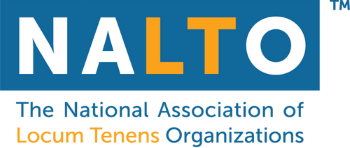ISMIE, a physician-owned medical malpractice insurance company that provides coverage to healthcare professionals, recently interviewed two NALTO leaders to learn where the locum tenens industry is headed.
Jarin Dana, NALTO President and CFO at Fusion Healthcare Staffing and Michelle Bousquet, NALTO Marketing Committee Chair and Vice President of Organizational Effectiveness at Floyd Lee Locums—sat down with ISMIE to lend their expert insights on the latest trends, challenges, and opportunities in locums.
During his interview, Dana highlighted the cyclical nature of locum tenens staffing, noting that while growth has slightly dipped from its 2023 peak, it remains significantly higher than pre-pandemic levels. Meanwhile, Bousquet emphasized the growing importance of a concierge-style recruitment approach prioritizing strong relationships over purely transactional placements.
Growth and Changes in Locums
Over the past two decades, demand for locum tenens providers has steadily grown, driven by physician shortages, evolving employment models, and healthcare facilities’ increasing reliance on flexible staffing solutions. As hospitals and clinics adjust to fluctuating patient volumes and financial constraints, locums have become critical for maintaining continuity of care.
 With this rising demand, staffing agencies are refining their recruitment strategies to attract top talent. Unlike traditional job markets that rely on online job boards, locum tenens recruitment is based on relationships and reputation.
With this rising demand, staffing agencies are refining their recruitment strategies to attract top talent. Unlike traditional job markets that rely on online job boards, locum tenens recruitment is based on relationships and reputation.
Bousquet explains that word-of-mouth referrals remain a key driver—when physicians have positive experiences with an agency, they’re more likely to recommend it to colleagues. To strengthen credibility, top firms focus on brand-building, industry recognition (such as the Staffing Industry Analysts’ Largest Locum Tenens Staffing Firms award), and specialized recruiter training to match providers with the right opportunities.
While technology and AI are becoming more prevalent in staffing, the locum tenens industry still thrives on a personal touch. As Bousquet notes, “Locums requires a human touch, and with AI increasing, it’s especially relevant now. There’s a gap for the human aspect in many things that we’re looking at, demoing, and trying to explore.” Agencies must balance efficiency and relationship-building, ensuring that automation enhances rather than replaces the personal connections that foster trust and long-term partnerships.
Bousquet and Dana also highlight the pandemic’s lasting impact on the industry. While the demand for locum providers has always been strong, COVID-19 intensified workforce shortages, accelerated changes in employment expectations, and underscored the advantages and limitations of technology in healthcare staffing.
“Locums requires a human touch, and with AI increasing, it’s especially relevant now. There’s a gap for the human aspect in many things that we’re looking at, demoing, and trying to explore.”
– Michelle Bousquet | NALTO Marketing Committee Chair
The Pandemic's Lasting Impact
The COVID-19 pandemic reshaped the locum tenens industry, amplifying physician shortages and increasing burnout, particularly in rural and underserved communities. “After the pandemic, or I should say on the heels of coming out of the pandemic, we saw a tremendous burst in demand,” says Dana.
Unlike other staffing sectors that saw temporary surges, locum tenens experienced sustained growth and broader acceptance as a necessary workforce solution. As facilities struggled to maintain continuity of care, long-term locum placements became essential, bridging staffing gaps while hospitals searched for permanent hires.
Beyond filling immediate shortages, the pandemic also shifted perceptions of temporary physician staffing. Once viewed primarily as a temporary fix, it is now widely recognized as a legitimate and respected career path. More physicians—especially early-career doctors and those nearing retirement—are drawn to locums for its flexibility, competitive pay, and work-life balance.
While mid-career physicians have traditionally been less engaged, evolving workforce expectations may change that trend as the industry adapts. Increasing flexibility in hiring criteria, particularly for new residency graduates, may become necessary to meet growing demand.
Who’s Going Locum Today?
 The locum tenens workforce is evolving, with increasing interest from two key groups: early-career physicians and those nearing retirement. Providers fresh out of residency are drawn to locum tenens for its flexibility, travel opportunities, and exposure to different practice environments before committing to a long-term role.
The locum tenens workforce is evolving, with increasing interest from two key groups: early-career physicians and those nearing retirement. Providers fresh out of residency are drawn to locum tenens for its flexibility, travel opportunities, and exposure to different practice environments before committing to a long-term role.
According to Dana, 20 years ago, locum tenens was often incorrectly viewed as a fallback option for physicians who couldn’t secure a permanent position. Today, the truth is it’s a respected career path that allows new doctors to gain experience while maintaining control over their schedules.
On the other end of the spectrum, late-career physicians are turning to locums to scale back without fully retiring. Dana explains, “A physician in their late 60s to early 70s, someone perhaps looking to retire, is a great candidate because they can get out of the busy rat race of having their practice or working for a large healthcare system.” Meanwhile, mid-career physicians—though traditionally less involved in locums—may take on temporary assignments for extra income, especially those with children heading to college.
Overall, the locum tenens lifestyle is gaining traction across all career stages, proving that today’s healthcare professionals value autonomy, variety, and balance more than ever. “Locums is one of the very few [healthcare] staffing verticals that has seen an increased need. There’s a greater demand for it and a greater acceptance of it,” Bousquet notes.
“A physician in their late 60s to early 70s, someone perhaps looking to retire, is a great candidate because they can get out of the busy rat race of having their practice or working for a large healthcare system.”
– Jarin Dana | NALTO President
The Future of Locum Tenens
As the industry expands, optimism remains high about its ability to address workforce shortages and provide essential flexibility for healthcare professionals.
More physicians than ever are embracing locums as a viable career path, and the industry’s adaptability ensures that providers can be placed where they’re needed most. Leaders in the field believe that further adoption of locums could help mitigate the growing physician shortage, allowing doctors to work on their terms while still delivering critical care to communities across the country.
However, challenges remain—particularly regarding regulations that could impact independent contractor status. As lawmakers consider changes at both state and federal levels, there is concern that restrictive policies could make locum work less accessible for physicians, worsening staffing shortages. Industry advocates, including NALTO, continue to push for policies that protect the locum model and ensure that both healthcare facilities and providers can benefit from its flexibility.
Despite these uncertainties, one thing is clear: locum tenens has cemented itself as a crucial pillar of modern healthcare.
With ongoing efforts to streamline licensing, address shortages, and support providers, the future of locum staffing looks bright—as long as the industry remains vigilant in protecting its core values of flexibility, accessibility, and quality patient care.



